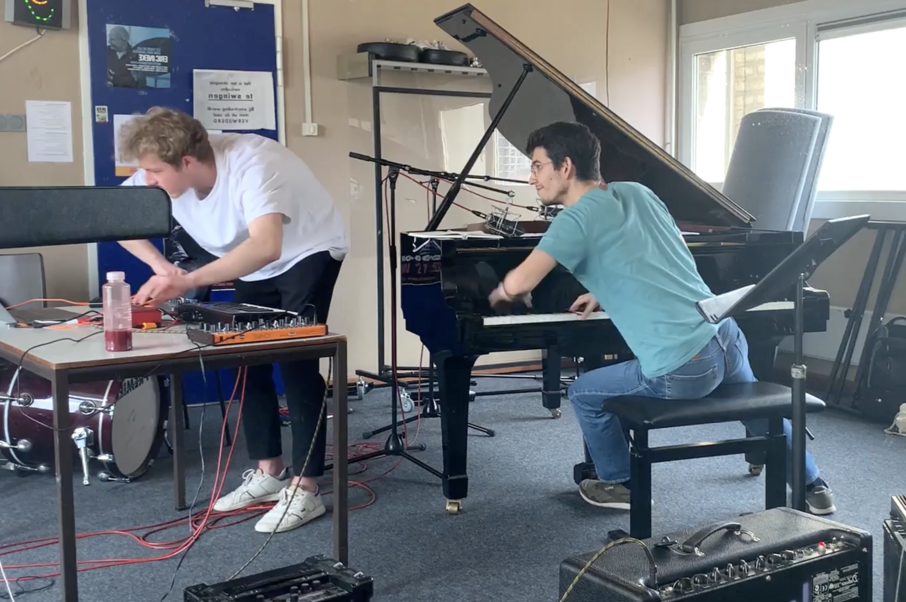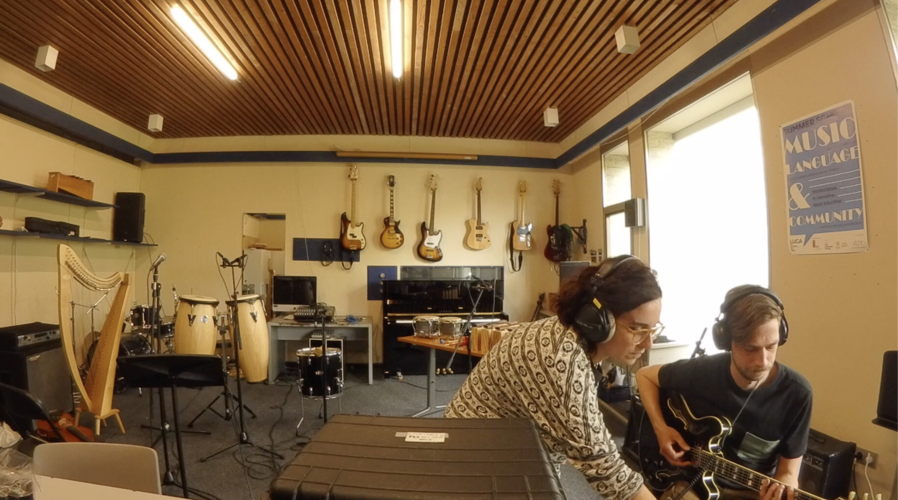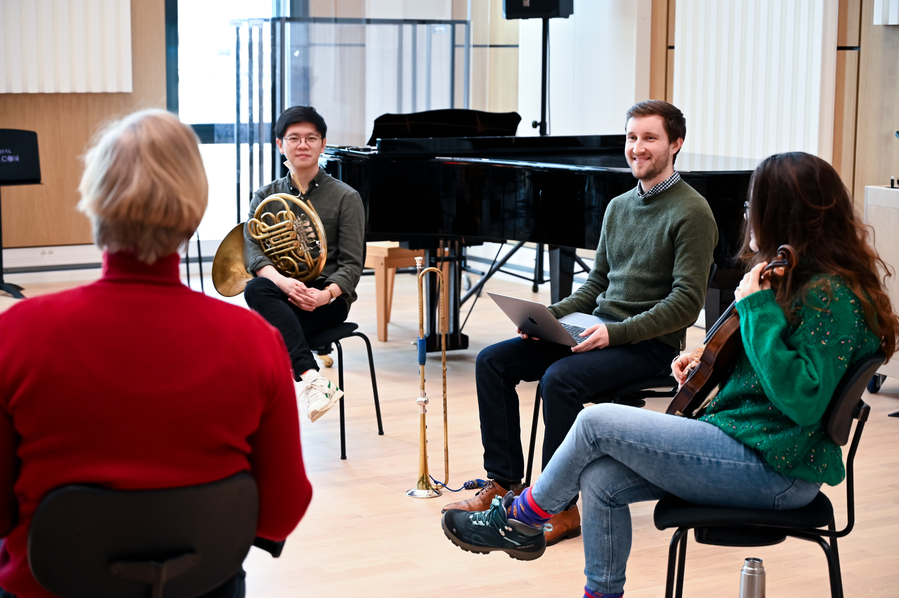Collaborative learning
There is a wide belief that collaborative learning between peers is a powerful resource in higher education and that it is increasingly utilized in universities (Hanken, 2016; Boud, Cohen, & Sampson, 1999).
Peer learning is an interaction between students in order to learn from and with each other. Students can share goals, strategies and feedback, observe how others learn, discuss problems and challenges and explore solutions together. Resulting benefits can include enhanced learning, motivation and a sense of belonging.
In higher music education there is still a strong tendency towards an apprentice-master model where the student practices alone to prepare each lesson. Considering that music-making is usually a collaborative activity involving several musicians and an audience there is a clear necessity for learning structures within conservatoires that support peer learning where skills, learning strategies as well as how to collaborate and connect can be explored.
In a study by Nielsen, Johansen and Jørgensen (2018), 96 conservatoire students in a Norwegian conservatoire were surveyed to see to what extent they experienced collaborative learning with their peers, how they thought it influenced their practicing and how satisfied they were with their own practicing and performing. Results showed that around 50% practiced some kind of regular (weekly) informal (extra-curricular) peer learning and discussed practicing with their peers. Around half of the students reported that peer-learning was beneficial and influenced their own practicing. Conclusions from the study point out that there was a large untapped potential for peer learning, and that although collaborative learning can be beneficial to the students’ learning and motivation, this did not effect their satisfaction with their own practicing and performing. Conclusions called for more understanding about what characterizes beneficial interactive learning contexts and add: We wish to suggest that peer learning forums, whether informal or formally instituted by institution, can function as a potentially constructive and supportive arena for reducing negative dimensions of competition and strengthen students’ inner motivation in practicing.
Collectives
We live in times where musical genres are becoming less defined and where musical cross-overs are more usual. It is no longer viable or even desirable to study music with the sole expectation of having a fixed employment for instance in an orchestra or ensemble. Most musicians today are portfolio musicians – combining various activities such as performing, teaching, instrument building and research.
A phenomenon that is increasing in the artistic community is forming collectives – where a group of artists join forces to share, inspire, create and produce. A conservatoire – with its many departments and people from many backgrounds – is also a collective where students can potentially explore and connect with other genres and departments.
Aims of this research
This research sought to design a beneficial peer-learning context based on a self-regulated learning framework that required the participants to set goals and document and reflect on their individual and group process. The actual content and ways of exploration were left to the students themselves. It was important that the timeframe was limited to five weeks – enough time to go into some depth but not so long that the activity might become boring, tedious or burdensome. The design was intended to stimulate autonomy (the students have choices and room to explore), competencies (there is a space and framework for learning), and relatedness (they are working with each other). Therefore it was expected that the 'learning pods' would have a positive effect on motivation.
A semi-structured peer-learning environment was designed and implemented and two learning pods were formed, each with a different theme. The first pod was the Performance Preparation Pod, which comprised of five instrumentalists, each of whom played a different instrument. Their aim was to prepare their upcoming exam recitals. The second pod was the Creative Collaboration Pod, which comprised of twelve musicians from five different departments and several different genres. Their aim was to create and curate an original performance together.
Qualitative data was collected to ascertain what the participants experienced and the effects on their motivation. The research questions were:
Musicians’ learning
Performing music at a professional level is probably the most demanding of human accomplishments (Altenmüller, 2007) and requires mastering sophisticated skills, including auditory and motor processing which are acquired over years of practice. Quality practice needs to be deliberate – i.e. be specific and using strategy and goals (Ericsson, Krampe & Tesch-Römer, 1993), and self-regulated – involving forethought and planning, self-control and self-awareness during playing and reflection and evaluation after playing (McPherson & Zimmermann, 2011). One of the most recent theories on motor learning – the OPTIMAL theory of motor learning – suggests that the best conditions for learning complex movements involve motivation and attention (Wulf & Lewthwaite, 2016).
A musicians’ practice (in the broad sense) is determined by the quality of their motivation and their attention and helped by their ability to self-regulate. Relevant information on motivation, attention and self-regulation are outlined below.
Motivation
Highly motivated students are more attentive to learning processes & outcomes, progress better and achieve higher levels of mastery, and are likely to persist more (e.g. practice regularly). Also they enjoy more satisfaction (Schunk & Zimmerman, 2012, p. 3). Why do some students seek challenges and persist in the face of difficulty while others (with equal ability and potential) avoid challenges and withdraw when faced with obstacles or difficulties? (Hallam, 2006). There is a great deal of research suggesting that motivation and self-regulation are more important to learning and success than aptitude. An individual who is highly and intrinsically motivated will stick with a task, find ways to achieve their goals and can learn to steer and regulate their own process.
“To be motivated means to be moved to do something” (Ryan & Deci, 2000). Motivation is usually referred to as intrinsic or extrinsic. Someone is intrinsically motivated when they find something interesting and enjoyable, and it involves willingness, volition and choice. Alternatively, extrinsic motivation means doing something because it leads to a certain outcome, e.g. for reward, approval or to avoid punishment. Extrinsic motivation has been found to be less effective than intrinsic motivation. Musicians who are steering their own process are likely to be more alert, engaged, active and invested in comparison to when they are following outside instructions or expectations. However, an individual can decide that something is important for them even if s/he is not intrinsically motivated. This can lead them to internalising the values of it and then experiencing it as their own: e.g. “I understand that ear training can really help my playing, so I will make a real effort to do the exericises”. Thus when extrinsic motivation is internalized and integrated it becomes self-determined and thus effective (Ryan & Deci, 2000).
The conditions that support intrinsic motivation as well as the internalization of extrinsically motivated tasks were outlined by psychologists and researchers Deci and Ryan (1985) in their Self-determination Theory. The theory focused on the quality of motivation and states that there are three basic human needs: autonomy, competence and relatedness. This means that every person has the need to master something, to belong to a community and to be autonomous. There are some important implications of this theory to the teaching of musicians. Music students need to feel competent – that they are able to master tasks (e.g. new repertoire) and develop skills. They also need to experience autonomy – by having choice and agency over their learning process, e.g. by choosing their own repertoire, developing and using their own strategies and creating their own projects. By playing together with and for other people and feeling like they belong to a community they can also experience connection and relatedness.
Attention
Quality of attention is a factor that contributes to a musician’s learning process. Knowing what to focus on and being able to stay ‘task focussed’ enhances learning and performance. This means that rather than focusing on the self or on avoiding mistakes, it is better to focus on the desired optimal result – for instance the sound or effect or meaning of the phrase or note that is about to be played. This is referred to as external focus (Wulf & Lewthwaite, 2016). For more information on attentional focus, see FINDING FOCUS exposition
Self-Regulation
Self- regulation refers to being able to steer one’s own learning process. Barry Zimmerman (2002) developed a model for self-regulation that shows a cyclical process with three phases: forethought, performance and self-reflection. The forethought phase involves formulating goals and strategies, and benefits from high self-efficacy and intrinsic motivation. The performance phase is characterised by the ability for self-control and self-instruction, imagery and attentional focus, as well as metacognitive monitoring. The self-reflection phase involves self-evaluation and self-assessment, and the ability to see what causes outcomes.
For more information on Self-regulation, see: SRL exposition
Introduction
In a world where time and attention are arguably our most valuable resources, the question of how to design effective and efficient learning environments is a crucial one for conservatoires. Performing musicians need expert tuition for playing their instrument (or singing) and learning repertoire and they need to practice, to rehearse and perform. Learning takes the form of absorbing knowledge, developing motor control as well as metacognition (the ability to observe one’s own thought processes). Conservatoires provide formal structures for learning and expect students to organise their own individual practice. Some students use their peers to practice together, exchange ideas and strategies and talk over problems and challenges. This usually happens informally. Considering how powerful peer learning can be, there are strong arguments for encouraging and offering ways for structured peer learning to take place within a conservatoire.
Musicians learn by doing – and this works best when they are exploring and experimenting and not only when they are receiving expert tuition. Almost every performance in a conservatoire is important in some way so there is little room for taking risks and joyfully learning from mistakes. What if we had spaces for our students where they can try out things, share ideas and strategies, and give each other useful feedback? What if we created 'safe and brave' spaces where students can be challenged and go out of their comfort zone - including collaborating with peers from other departments, genres, and backgrounds?
What kind of environment could facilitate this? We need structures that are robust but flexible, and have space inside for creativity and exploration. This research set out to come up with a design where peer-learning could be harnessed in a way that could enhance musicians' learning process.










